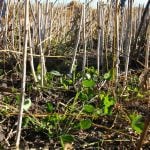There has been a long-time, ongoing debate on how to regeneratively graze. Which is the right way? Who should you follow? There are many different schools of thought out there by several very experienced graziers on how to properly graze, but which method is the best? I have attended a lot of different schools on grazing over the last 25 years and the one thing I have found is that they are all right in their context. I like to think that what I do on my ranch is a blend of every method and everyone that I have followed over the years. My short answer when people ask me how I graze: I do everything, sometimes.
Read Also

Mycoplasma bovis in beef cattle causes more than pneumonia
M. bovis causes pneumonia and is a major cause of infectious arthritis in calves and feeder cattle
Once you get your head wrapped around the basic concepts and principles of regenerative grazing, I think that one of the tools in our toolbox is change. If you think back to how nature would have managed the landscapes with predators and grazing herds, do you think that it was always grazed the same way? No, I don’t think so. I do not like seeing grazing portrayed as a recipe. It is not a one-size-fits-all. Grazing is more of an art with science mixed in, or is it a science with some artistic flair? You choose but it is definitely not a recipe.
Even today, every year is different. Every environment is different. Every herd is different. I would think that maybe our grazing should be different as well. I like to add change to my grazing plans every year on purpose. I believe the change is a stimulant to the whole system. Sometimes we need to manage for the soil, sometimes for the livestock and sometimes even for the people.
What can we change?
1. How about the starting point? I know that most of my pastures have access off the road and that is usually the easiest place to unload and start grazing. But then that paddock always gets hit first. How about we unload at the far side this year? Let’s hit one of the other paddocks first thing in the spring and start the rotation from there. It is okay to mix it up a bit.
2. If the first paddock is the only access, then what about changing the direction of the rotation? Some years I try to plan my rotation in a different order to stimulate some paddocks and rest others.
3. How about stock density? This is a popular debate. Do we take half/leave half or use ultra-high stock densities? On some paddocks, I will increase my stock density to knock it flat. Ultra-high stock density or mob grazing will completely flatten the sward. This can have some great improvements to the pasture if done properly and not done during extremely wet times. However, it can also lower performance from the livestock and can increase stress, depending on the situation. We also have to factor in the labour and equipment costs. What works in one situation might not work in another. In some cases, I might want to lower stock density to manage for the livestock or even for the people. The stress of both needs to be accounted for. Every farm has a different context.
4. How about the type of livestock? Is it possible to graze the cattle in one area one year and the next use sheep? Or pigs? Or chickens? How about mixing it up a bit? Goats with the cows? I have a friend that loves to add in 10 per cent horses with his cow herd to create a bit more animal impact. It is because of the pecking order. If you have ever seen a few horses run through a herd of cattle, you will know what I mean. A great tool that I use here is to add in a few cow-calf pairs to a yearling or bred heifer herd. The cows teach the teenagers how to behave.
5. Can we change the class of livestock? One year I might graze cow-calf pairs on a pasture but the next year we bring in yearlings or even bred heifers. I graze them differently as their needs are different and the owner’s goals might be different. (As a custom grazier, I don’t own the cattle.) Yearlings need high-quality forage to get good gains and they usually get a shorter season. The owners usually want them back early in the fall to start feeding the silage they spent all summer putting up. With yearlings, we will increase our stocking rate and graze hard and fast. Cow and bred heifer owners want them to stay on pasture for as long as possible so we lower our stocking rate and aim for a slower rotation with a longer season. With young calves on the ground, I might not want to be moving hard and fast. It depends on a lot of factors but stress is very important on calf gains and overall herd health.
6. Can we plan to heal the land? If we are just taking over a piece of ground or maybe we have just come through a drought, I might decide to do a major repair to the soil armour in a particular area. Every grazing I like to leave residue but some years I will back way off on my rotation or simply skip a paddock or two, to rest the land. I call this deferred grazing as I let it mature. The roots get to dig down deep, we allow the plants to set seed and add to the seed bank. This also leaves all the litter on the soil surface. Now we can’t just leave it standing there. That winter or maybe the next spring we will come in with higher stock density and trample all that material to the ground. Of course, nutrient quality will be much lower so we will have to supplement or animal performance will be poor.
There are many other situations and many other factors that might cause us to change our grazing plans. Nature likes to throw curveballs. I like to start with Plan A, but I usually finish somewhere around Plan Q or Plan R. Don’t be afraid of change. In my grazing plan, change is always included. Life is too boring if you just follow a recipe.

















